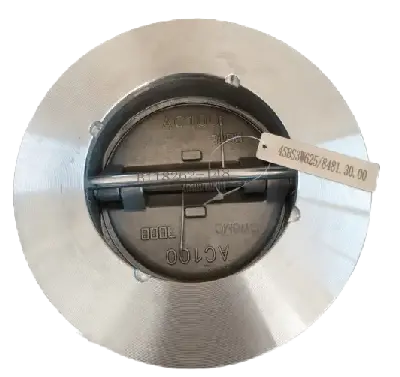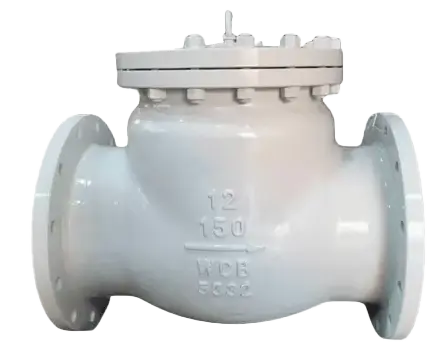сравнение бабочек обратных клапанов и качательных обратных клапанов
Oct 29, 2024
On this page
In the field of fluid control, butterfly check valves and swing check valves are two common types of check valves. While their primary function is similar, namely, preventing backflow, enabling light-load pump starts, and reducing water hammer, they differ significantly in structure, suitable applications, connection methods, and installation flexibility. This article provides a detailed comparison to help users make informed choices.
Both butterfly and swing check valves have distinct structural designs. Butterfly check valves feature a disc that is connected at the center by a pivot, allowing for quick opening and closing during fluid flow, making them suitable for high-flow applications. In contrast, swing check valves rotate around a pivot point on the valve seat, with the pivot located at the edge of the disc, resulting in lower flow resistance, ideal for medium to small pipelines.
Disc Design: The disc is circular and typically located at the center of the valve body, connected by a pivot that passes through the middle of the disc and is positioned within the flow path. This design allows the disc to open or close quickly as the flow direction changes, effectively preventing backflow.
Slow-Close Feature: Due to the significant inertia of the disc, butterfly check valves often incorporate a slow-close design to reduce water hammer effects, thus protecting the integrity and safety of the pipeline system. They are particularly suitable for large flow and low-pressure environments.

Disc Design: The disc is also circular, but the pivot is located on the outer edge of the sealing surface, passing outside the flow path. This allows the disc to swing around the pivot, creating a streamlined passage with relatively low flow resistance.
Variety of Forms: Swing check valves can be single-disc, double-disc, or multi-disc, with the choice depending on the valve size and application. This variety helps effectively reduce hydraulic shocks caused by the stopping or reversing of flow, enhancing system stability.

Butterfly check valves and swing check valves have different focuses regarding suitable applications and media. Butterfly check valves are mainly used in low-pressure, large-diameter pipelines, suitable for handling low-viscosity fluids like water. Swing check valves, on the other hand, have a broader range of applications and can handle various media, fitting medium to small pipelines for different operational needs.
Application Range: Primarily used in low-pressure, large-diameter pipelines, especially in water systems. Their diameter can reach DN5000, making them ideal for low and medium-pressure environments, capable of handling large fluid flows.
Media Types: Suitable for low-viscosity fluids like water, offering excellent flow characteristics and effectively preventing backflow, ensuring the safety and stability of the pipeline system.
Application Range: These valves are more versatile, suitable for medium to small pipelines, typically ranging from DN15 to DN600. Their design accommodates various low, medium, and high-pressure pipeline conditions, providing good applicability.
Media Types: Capable of handling multiple media types, including water, steam, oil, and chemicals. Depending on the media requirements, different materials can be selected for the valves to meet specific operational needs.
Butterfly and swing check valves exhibit different characteristics in connection methods.
Connection Design: Typically use flange connections, which are essential for large-diameter products. Smaller sizes often utilize wafer connections. Flanged connections facilitate easier installation and maintenance while accommodating high flow demands.
Connection Flexibility: Swing check valves offer more diverse connection methods, including flanged, threaded, wafer, welded, and clamp connections. This flexibility allows them to adapt to various installation environments and process requirements, providing users with more choices.
Both valve types have unique advantages in installation and applications. Butterfly check valves can be installed in various positions, making them widely used in water systems. Swing check valves, due to their compact design, are suitable for space-constrained areas and perform effectively in various industrial and chemical applications.
Installation Position: These valves can be installed in horizontal, vertical, or inclined pipelines without restrictions, making them versatile for different engineering scenarios. Micro-resistance slow-close butterfly check valves are particularly suitable for drainage pipelines carrying clean water, wastewater, and seawater, effectively preventing backflow and limiting water hammer damage, ensuring pipeline safety.
Considerations: Despite their wide application, they should not be used with solid particles or high-viscosity media to avoid blockage or damage.
Wide Application: Due to their superior sealing performance and low flow resistance, swing check valves are widely used in various pipeline systems. Their compact and lightweight structure is ideal for installation in space-limited areas, making them popular in industrial, construction, and chemical fields.
Operational Efficiency: The low flow resistance of swing check valves is suitable for applications with minimal flow rate changes and large volumes, ensuring efficient fluid transport.
In summary, butterfly check valves and swing check valves each have their unique features in structure, application range, connection methods, and installation flexibility. When selecting the appropriate check valve, users should consider specific conditions, media types, and pipeline sizes to ensure safe and efficient system operation. By understanding the distinct characteristics of these two types of check valves, users can better meet the demands of different engineering projects and optimize the performance of fluid control systems.
Cледующий: как преобразовать ручные задвижки в электрические задвижки
Предыдущий: конструкция и ключевые характеристики задвижки сильфонного уплотнения
О нас
Продукция
Навигация
Our Contacts
Building 2, NO.59, Songshan Road, SND, Suzhou, China
